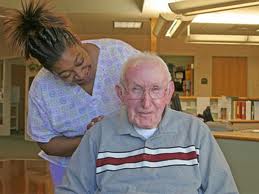
Local in-home care companies offer solution
A new government report revealing seniors receive substandard care in some taxpayer funded nursing homes has some families in our city, and throughout the nation, turning to an alternative – in-home care for their elderly loved ones. According to the newly released report from the Department of Health and Human Services, Medicare paid for patients to stay in nursing homes that were not meeting basic care requirements and in some cases are dangerous and neglectful. In fact, one out of every three times patients wound-up in nursing homes in 2009, they landed in facilities that failed to follow basic care requirements.
That’s why Visiting Angels, one of our nation’s largest in-home senior care companies with a center in our area, offers families an alternative – care for seniors right in their own homes. In-home senior care is a growing concept here in our city and nationwide; it allows seniors to stay at home with dignity while caregivers come in to help with a variety of tasks such as bathing, medication reminders, running errands, cooking meals, or simply keeping seniors company.
“We are not saying all nursing homes are bad. We are saying in-home care provides families with an alternative if they don’t want to put their loved ones in a home,” says Larry Meigs, President and CEO of Visiting Angels, a national in-home care company with a center in our city. “We offer seniors one-on-one personalized care they often can’t get in facilities. Many facilities are understaffed and Visiting Angels can fill that void. The elderly want to stay in their own homes and families often feel guilty taking them out of their homes. That’s why in-home care is a solution that can make everyone feel at ease. And it’s often the most cost effective solution.”
Pros of In-Home Care Vs. Nursing Homes
- Cost: The average cost for in-home, non-medical care is $19/hour. If you calculate care for 4 hours a day/5 days a week, that adds up to only $19,760/year.
*From 2005-2011, the cost of facility living increased more than 4%/year – while the cost of in-home care has slowly climbed by about 1%/year.
- Relationships: In-home care offers one-on-one service/relationships with the senior on the senior’s schedule, not the facilities’ schedules. In nursing homes, caregivers often deal with a number of patients and follow a schedule that may not align with the senior’s needs.
- Choose Your Caregiver: With Visiting Angels, you can select your caregiver to make sure he/she is the right fit for your elderly loved one. At a nursing home, you usually can’t choose.
- Longer Life: A U.C. San Francisco study reveals seniors don’t live very long once placed in a nursing home. According to the study’s sample of nursing home patients who died between 1992 and 2006, 80% had died within one year of moving into the nursing home (Journal of the American Geriatrics Society).
*53% of the nursing home residents in the study pool had died within just six months.
*Researchers say 1/4 of Americans now die in nursing homes.
Nursing Home Allure
- When families choose a facility, they often want peace of mind for themselves vs. listening to the wishes of their elderly loved ones.
- Families are often lured by the idyllic, plush settings of facilities but lose sight of familiar knick knacks and surroundings in seniors’ homes that make them feel comfortable and safe.
- Families often see an upfront cost of a facility and assume that will be the total. They don’t realize that rates often go up and can be more expensive than anticipated.
“In the U.S., someone turns 65 in this country every 13 seconds,” says Meigs. In-home senior care is booming as an option because families realize it’s the best way to give their elderly loved ones the one-one-one, specialized care they need with a caregiver who often becomes like part of the family. Plus, in-home care alleviates the guilt of ‘sending a loved one away’ and helps ease the tremendous burden and pressure caring for an elderly loved one can bring on a family.”
How to tell this story:
Interview local families about the emotional struggle when deciding how to best care for an aging loved one. Talk with local senior care experts and caregivers about the options for elderly care and why in-home care is a viable solution.
What Lies Ahead for the U.S.*:
Source: U.S. Census Bureau
• There are currently about 37 million seniors in the U.S.
• Seniors account for 12 percent of the population
• As Boomers age over the next 2 decades, there will be more than 70 million seniors in the U.S.
• Seniors will account for more than 20 percent of the population by 2030
• At that point, 1 in 5 Americans will be a senior





Senior Home Care Nurses rendering their care and service to a particular age.
This is an excellent article. Lots of useful information. I also believe that there are lots of problems with the current health care programs for seniors and do believe that some people could do a lot better with the help of a virtual companion.
The GeriJoy Companion improves quality of life for seniors and connects and engages families.
It is a software service that takes the form of an intelligent pet inside a tablet device (iOS or Android). It does not require any technical skills, because the patent-pending technology creates the experience of interacting with a live animal. Available on-screen 24/7, the pet reacts realistically to touch and care, providing the proven health benefits of pet therapy even for seniors who are not able to care for a live animal.
Feel free to visit http://www.gerijoy.com for more information.